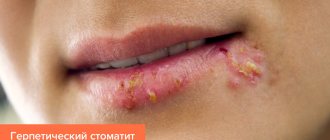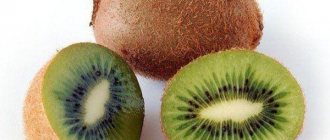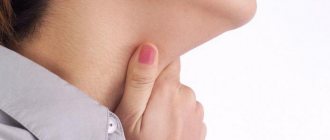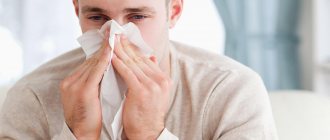Causes of facial allergies
Atypical reactions of the immune system to foods, chemicals and biological substances can cause rashes, pimples, redness, swelling and itching. The person experiences physical and moral discomfort. The manifestations of allergic reactions are varied and depend on the individual characteristics of the body. Most often, localization is observed on the forehead, temples, cheeks, behind the ears, in the décolleté area and on the neck. The most common prerequisites for allergies are:
- heredity;
- consequences of long-term use of medications;
- unfavorable environment;
- constant stress;
- reduced immunity;
- too high a concentration of certain substances;
- insect bites;
- cold or direct sunlight.
There may be other reasons; you need to approach the problem individually.
Allergies to foods and medications
There is often cross-reaction to the protein in this group, making it difficult to find the source. The speed of onset of symptoms can vary from immediate to a period of 2-3 hours. In the case of medications, the prerequisite is overdose, long-term use, too many drugs taken during the day.
Sun or cold
The body’s response is characteristic not only of winter. This could be water or food at a certain temperature. The appearance of photodermatitis is promoted by internal and external causes. Within a day or a little later after exposure to the sun, soreness and itching of the skin begin to bother. When an allergic rash appears on the face of an adult, treatment should begin immediately, otherwise the situation will worsen with each passing hour. As part of complex therapy, immunostimulating cosmetics such as Laennec are effective. Before use, you should consult with specialists.
Reaction due to eczema
Skin diseases significantly reduce the body's resistance, and any violation provokes their exacerbation. Most often, the reaction appears externally in the form of small bubbles with liquid. The acute form can become chronic, which subsequently leads to relapses.
Errors in diet
Various dietary restrictions do not go out of fashion. There are programs based on the consumption of one or just a few products for a long time, which leads to an oversaturation of the body with certain elements, since in this case there can be no talk of balance. You should not be surprised at the deterioration in well-being, since such restrictions become the causes of severe allergies on the face of an adult, the treatment of which is carried out comprehensively and will take a lot of time.
We recommend
GHC Placental 3D Mask withQ10
Serum concentrate
Repairing cream with a moisturizing effect
Placental antioxidant lotion concentrate
Contact with animals, insect bites
A swollen nose and watery eyes when trying to pet a pet are a true classic of the genre. Mosquitoes, bedbugs and other blood-sucking creatures can also cause itching and redness on the skin. The toxins they inject in large quantities cause a rash, often accompanied by fever. In this case, external agents and antihistamines are recommended; dosages should be confirmed with a doctor.
Allergies due to stress
In addition to nervous tics, there are other reactions to emotional overload. Unconsciously, a person may scratch or clench their hands tightly. If such situations happen regularly, then health problems may begin. Itching, swelling of certain areas, redness, and difficulty breathing appear. The main direction of stabilizing the condition is the prescription of sedatives, breathing exercises aimed at calming the nervous system, ointments and gels to relieve external manifestations on the skin.
Causes of facial skin diseases
Any skin diseases on the face do not occur on their own. They are, as a rule, provoked by third-party factors, with the search for which the treatment of any skin disease begins.
Improper skin care This is the most common cause of all kinds of problems and diseases of the facial skin. Thus, improper care can lead to severe contamination of the dermis and the proliferation of bacteria on it, which can ultimately lead to quite serious consequences.
Heredity It is very difficult to put in order the skin, the poor condition of which is caused by a person’s heredity. However, proper care for her, a healthy lifestyle and proper nutrition can significantly improve her condition.
Lifestyle Frequent stress, an unfavorable work environment, smoking, drinking alcohol, and poor-quality food - all this can affect the condition of the facial skin and even lead to skin diseases.
Diseases of internal organs As a rule, skin diseases on the face indicate improper functioning of the digestive system, kidneys or blood vessels. Also, weakened immunity, viruses and infections can provoke the appearance of acne, age spots and other skin problems.
Problems with the nervous system The main causes of various small rashes on the skin of the face are stress, which, unfortunately, awaits a modern person at every turn.
Types of allergies on the face
If in children the most vulnerable area is the buttocks, where signs appear that indicate certain foods or unfavorable conditions, then in adults this is the nasolabial triangle, eyelids, lips, tongue, neck and hands.
Atopic dermatitis
Chronic inflammatory skin disease. Most often begins in early childhood. The priority prerequisite is genetic predisposition. It can be a concomitant disorder with bronchial asthma and conjunctivitis. There are infant, child and adult forms of the disease.
Hives
Allergies and rashes in the form of pimples on the face, the photo of which most often appears on advertising posters of the newest antihistamines, occurs with a seasonal variant. It is characterized by lacrimation, swelling of the eyelids, obsessive itching, and redness of certain areas of the body.
Food reactions can occur instantly when certain foods enter the mouth and esophagus. Most often they are milk, eggs, red or yellow fruits, and nuts. Peanuts are the most dangerous in this regard.
Contact dermatitis
Recognizable by clear zones of irritation. The causes are hygiene and cosmetic products, chemicals that come into contact with unprotected skin, jewelry, piercings, latex products, extracts and juices of certain plants. It manifests itself in the form of weeping erosions, in place of which dry scales then appear. To understand how to remove facial allergies, you need to find and eliminate the substance that causes your health to worsen. Often a good result comes from moving to another region. This way, it is possible to cut off some of the options; for the rest, you will have to take special tests in the laboratory.
Toxicoderma
A distinctive point is inflammation not due to external factors, but due to the penetration of a provoking substance into the body. In some cases, it can cause secondary damage to internal organs and anaphylactic shock, since it develops rapidly from the ingestion of an allergen from the inside. One way to prevent inflammation is to take antibiotics, especially penicillin. At the same time, timely treatment gives good results.
The alimentary variety is included in a special group; the deterioration of the condition is provoked not by products, but by food additives in their composition. It is quite dangerous due to the fact that it can occur suddenly, since manufacturers do not indicate all the ingredients in the composition.
Quincke's edema
It poses a direct threat to life. In the question of what an allergy on the face and neck looks like in this case, what to do and how to treat it, time is of the essence. Choking occurs quickly, and the slightest delay can have fatal consequences. An acute inflammatory reaction of the body, which occurs locally in the skin and subcutaneous tissue, affects deep layers, including the muscles of the respiratory system, and in a third of cases is localized in the larynx. It is impossible to prevent the development of Quincke's edema. Women suffer from this disorder more often. The diagnosis is made based on the clinical picture and requires medical attention. Signs may persist for several days and disappear gradually. Treatment includes the administration of potent antiallergic drugs. In severe cases, the patient requires urgent hospitalization in an intensive care unit or intensive care unit.
What does an allergy look like on the face?
There are many manifestations of allergies, and they depend on the form, location and intensity. The main indicator of the disorder is sudden swelling of the eyes and lips, one or both. Changes also affect the structure of the skin. It becomes lumpy, swollen, with a small scattering of small dots. Red, uneven spots of varying sizes often appear. Cracks and a scaly structure may be observed. If you give in to temptation and start scratching the itchy areas, the condition will quickly worsen.
Depending on the type of disorder and the affected area, allergic rashes on the face are likely, the treatment of which requires an integrated approach. Along with pharmaceutical drugs, cosmetics have a fairly good effect. Plasma therapy with the Japanese drug CURACEN perfectly restores appearance, but only after the acute period ends and the condition stabilizes.
Bruises and hematomas of the face.
Bruises are the result of a mild blow to the face with a blunt object. In this case, subcutaneous fatty tissue (SFA) and facial muscles are damaged without tearing the skin. Hemorrhage occurs and pronounced post-traumatic tissue swelling appears, that is, a superficial or deep hematoma is formed.
Deep hematoma - blood enters the interstitial space forming a cavity.
Superficial hematoma - imbibition (soaking) of tissues with blood occurs without the formation of a cavity. The nature, color and time of resorption of the hematoma depend on its location, depth and size of the damage. The outcome of hematomas is most often favorable; they completely resolve without leaving any trace.
The nature, color and time of resorption of the hematoma depend on its location, depth and size of the damage. The outcome of hematomas is most often favorable; they completely resolve without leaving any trace.
Bruises, hematomas and abrasions are the mildest types of injury, but are they so harmless?
How to diagnose allergies
The main difficulty is to distinguish it from a skin disease. Rashes should not be a reason for panic, but a prerequisite for examination. To prevent exacerbation and speed up the process of identifying causes, it is necessary:
- try to independently identify the allergen by eliminating cosmetics or products from everyday use, doing this gradually in order to replace the changes in time;
- take an antihistamine that has already been used as prescribed by a doctor;
- Remove all alcohol-based external care products from use.
After such measures, it will be much easier to determine how to relieve an allergic reaction on the face and alleviate the general condition.
We recommend
GHC Placental 3D Mask withQ10
Serum concentrate
Repairing cream with a moisturizing effect
Placental antioxidant lotion concentrate
How can hematomas be dangerous?
Often, a more serious damage to facial tissue is hidden under a hematoma - a fracture. Therefore, most facial soft tissue injuries require careful analysis and careful x-ray examination. For a more detailed study of the bones of the facial skeleton of the skull, we use a computed tomograph. With its help, you can identify even subtle damage to bone structures and prevent possible complications.
Unfortunately, there are “folk methods for treating bruises and hematomas,” which result in complications in the form of their suppuration. Any warming compresses, ointments, bandages can only aggravate this situation.
All that is needed to prevent the process of suppuration is cold, a pressure bandage and a thorough examination by a specialist.
Facial wounds.
Wounds and abrasions on the face have a number of specific features. This is the superficial location of the vessels, the presence of facial muscles, as well as the close location of important organs.
However, wound healing in the maxillofacial area has a high regeneration potential due to increased blood supply and good innervation in the facial area.
Treatment
It is not recommended to use drugs other than antihistamines on your own. In most cases, they are enough to eliminate the main symptoms and relieve swelling. It is necessary to take into account that the action must be comprehensive and must include creams, ointments and gels to relieve external signs of the disease.
Preparations for internal use
Medicines prescribed by a doctor are divided into corticosteroid and non-hormonal. The first are produced on a hormonal basis, have a powerful effect, but have a number of serious contraindications for long-term use. The second, milder ones, are prescribed to relieve mild forms of irritation. Several generations of antihistamines are available in pharmacies. If the former, such as Suprastin, influenced the level of attention, causing drowsiness and inhibition of reactions, then Cetrin, Telfast, Claritin, with high efficiency, do not give side effects that could become a limitation for work in areas where concentration is required.
Cosmeceuticals and their help in the fight against allergies
When the body reacts violently to a stimulus, skin lesions are sure to appear, and sometimes quite unpleasant ones. These are not only rashes and pimples, but also increased dryness and microcracks. Their danger lies in the possible entry of bacteria and the development of local inflammation. The main task, along with eliminating illness, is strengthening the immune system. Cosmetic products from the medical corporation "RHANA" are used in professional problem solving, provide a quick and lasting positive effect, allowing you to maintain beauty, health and prevent premature aging. And the skin is susceptible to it if an allergic reaction often appears on the face, a photo of which clearly demonstrates the degree of damage to the integument.
In order to give a fresh look and ensure cellular renewal, it is recommended to use placental preparations:
- Modeling mask with placenta hydrolyzate GHC Placental 3D Mask withQ10. It will prevent the risk of developing inflammation and give a healthy tone.
- Concentrate serum for intensive revitalization GHC Essence will instantly restore inner radiance, and also improve microcirculation and cell nutrition.
- LNC Repairing Cream with a moisturizing effect will preserve the beauty and freshness of the skin, and also protect it from moisture loss and eliminate the regeneration of ceramides (epidermal cells).
- Placental antioxidant lotion concentrate LNC Toning Lotion will protect cells, normalize melanin production and provide optimal hydration.
The dangers of self-medication
According to preliminary forecasts, the number of people reacting to certain stimuli will reach almost 90% by the end of the century. Allergists-immunologists mention the fault of allergy sufferers themselves, who, by self-medicating, expand the range of allergens and provoke the development of other diseases. In this case, the part is fixed and passed on by inheritance. By identifying the cause and drawing up an optimal treatment regimen, you can almost completely eliminate the likelihood of regular exacerbation of allergies.
Causes of the disease
The reasons for the development of the disease are not completely clear. Seborrheic dermatitis is not a disease of the sebaceous glands, although it develops in areas saturated with them.
A significant role in the development of the disease is played by yeast-like fungi of the genus Malassezia (they exist on the skin of most healthy people, but in some they can cause rashes and skin irritation), the composition of lipids on the surface of the skin, as well as the characteristics of the immune response to Malazessia fungi and their metabolic products.
In adults, severe disease is associated with the following conditions:
- oily skin (seborrhea);
- lack of sleep and stress;
- history of seborrheic dermatitis and psoriasis in relatives;
- states of immunosuppression (organ transplantation, HIV, lymphoma);
- neurological or psychiatric disease.
The main cause of seborrheic dermatitis in children is increased activity of the sebaceous glands (rapid growth and secretion of sebum), which occurs due to the circulation of maternal hormones in the child’s blood in the first weeks of life. Malacesia is not a leading factor in children, unlike in adults.
Preventive measures
In order not to look with disappointment at your reflection in the mirror and not to wonder how to get rid of allergies on your face once again, you should listen to the simple but effective advice of specialists.
- Adjust the daily menu by removing from the diet foods that provoke the appearance of characteristic symptoms of an immune disorder.
- Do not use cosmetics based on alcohol and other aggressive substances, giving preference to soft and neutral ones.
- Do not stay in the sun for a long time, and in winter, protect your skin from the cold as much as possible.
- During seasonal exacerbations of hay fever, use inhaled isotonic saline solutions to reduce the concentration of pollen in the nasopharynx.
- Always keep in your medicine cabinet an antihistamine recommended by an allergist-immunologist.
It is worth remembering that angioedema alone cannot be prevented. Other types of allergies are completely preventable, and this is much more effective than constantly treating exacerbations. Immunity support should take the leading place in the list of mandatory activities.
Why are allergies on the face dangerous?
A scattering of small specks or red spots not only look unsightly, but also pose a hidden threat. Acute inflammation, accompanied by swelling, can spread to the neck and make breathing difficult.
Violation of the structure of the skin, accompanied by a feeling of tightness, reduces the natural resistance to external influences. Weeping areas, as well as cracks in the upper layer of the epidermis, create a favorable environment for the proliferation of pathogenic bacteria, which leads to the appearance of pimples and ulcers. When such a condition occurs and is not treated, there is a high probability of it becoming chronic. In addition, an unpresentable appearance can cause a sensitive blow to pride and cause problems in communication.
If an allergic rash appears on the face, a specialist from a clinic or health center will tell you how to treat it. It is better to contact him at the first signs in order to make a timely diagnosis and receive an effective treatment regimen to avoid complications.
Ways to get rid of post-acne
The intensity of post-acne is directly related to the severity of acne. Therefore, it is important to work not only to eliminate the consequences, but also to prevent the appearance of new elements on the skin. It is necessary to fight acne itself, eliminating its main causes. If pimples appear again and again, the prognosis for post-acne treatment is questionable; inflammation will give rise to new scars. Therefore, work with an experienced dermatologist-cosmetologist is required.
Most of the work on restoring, smoothing the skin and eliminating scars is carried out by a cosmetologist, but certain activities can also be performed at home. Moreover, only an integrated approach will give the most maximum results.
What can you do at home?
At home, you need to help the skin recover; it needs building elements and proper nutrition. To regenerate the skin and form its structure, it is necessary to supply vitamins and minerals, protein as a source of amino acids for the construction of collagen fibers and the synthesis of hyaluronic acid, which moisturizes and gives the skin tone and smoothness.
In addition, omega acids are important, which are involved in cell renewal and form cell membranes. It is important to adjust your diet, eliminate as much processed foods as possible, food chemicals (dyes, preservatives, E-additives) and give up bad habits.
To prevent new acne and improve tone, nourish the skin, heal inflammation and small scars, pharmaceutical products will help. You can use 1% salicylic alcohol or boric acid and wipe the skin with it twice a day. Levomekol ointment works quite well in treating acne, suppressing inflammation and eliminating scars. Many people use bodyaga powder, which is diluted in water to a paste and applied to the affected area. But before using all these remedies, it is important to first consult with your doctor to prevent side effects and complications.
Skin care is complemented by serums, care creams (day and night) selected by a cosmetologist, as well as homemade peelings with fruit acids. They delicately exfoliate the skin, remove dead cells, and cleanse its surface.
Folk remedies are often used, for example, infusions of St. John's wort and chamomile, which have an anti-inflammatory, soothing, cleansing effect. You can freeze them and wipe the skin with the resulting ice cubes, further increasing blood circulation and capillary tone.
You can also use masks with blue clay. The recipe for making a mask is very simple: three tablespoons of powder are diluted in water to a paste, applied to the problem area for 20 minutes and then thoroughly washed off with water.
What treatment methods are used in a cosmetology clinic?
Although homemade recipes help in the fight against post-acne, you should not think that only through them you can eliminate all problems. Home methods act on the very top layers of the skin and reduce only minor defects.
Modern cosmetic procedures will help get rid of deep scars, pigmentation and unevenness. But don't expect instant results.
Treatment methods are selected individually and comprehensively. The more severe the initial problem and the wider the affected area, the longer the treatment will be.
To achieve maximum smoothness of the skin and an even complexion or eliminate blemishes on the body, you need a whole series of procedures, supplemented by home care and carefully selected cosmetics. On average, the first noticeable results will be visible after 1-2 months with regular implementation of all necessary treatment measures.
If there is unevenness, decreased skin tone, pigmented or stagnant spots, peelings . There are a lot of treatment options: these can be mechanical peels (compositions with herbs, small dense particles) and chemical peels (with retinol, glycolic, resorcinol or other compounds).
With mechanical peeling, the effect of cleansing and exfoliation is achieved due to the mechanical scraping of the particles included in the composition of the upper layer of skin with outdated epithelial cells.
With chemical peeling, a similar effect is achieved through chemical cauterization of the upper layer of the epidermis, which leads to its subsequent rejection with peeling.
The cosmetologist selects peelings to suit your needs and strictly follows all the rules for their implementation in order to achieve maximum effect and avoid side effects. On average, the first results are visible after 5-6 procedures.
A more effective analogue of peeling is laser skin resurfacing . The doctor performs the procedure with a special laser unit with a strictly specified wavelength in order to influence the skin at the required depth without damaging neighboring tissues. The laser beam cauterizes the skin, the treated areas are actively exfoliated, which allows stimulating the regeneration of new tissues, more even and smooth.
Check out our patient's review of laser facial resurfacing:
Photothermolysis is a more advanced method of laser skin treatment. The rays do not act as a continuous field, but as individual points - creating a mesh on the treated area. This is a fairly effective, but less traumatic effect; the rehabilitation period after such procedures is reduced.
dermabrasion is used to combat skin imperfections . This is the use of aluminum oxide powder under pressure or a special rotating abrasive disc for mechanical grinding of the skin, removing the upper layers of the epidermis from it.
Filler injections can help eliminate atrophic scars and dimples and smooth out the skin . They are inserted under the defect area, create additional volume, and lift depressed skin. The effect lasts up to 6-10 months (depending on the drug), then the injections are repeated.
Mesotherapy with drugs that stimulate collagen synthesis and epidermal renewal gives good results A series of microinjections are made into the surface layers of the skin with the introduction of hyaluronic acid, antioxidants, and vitamin components. The cosmetologist selects a specific drug depending on the tasks and the severity of skin defects.
Another method is ozone therapy . This is a technique of introducing a special oxygen mixture into a problem area through a series of microinjections. The composition helps saturate tissues with oxygen, stimulates blood circulation or lymph drainage, and epithelial regeneration.
If no other methods have produced a significant effect, surgical removal of scars can be used. The affected scar tissue is excised within the boundaries of healthy skin. The rehabilitation process is long, and the intervention itself can also leave scars in the future.
Post-acne treatment at Dr. Gruzdev’s clinic:
Chemical peeling The clinic offers gentle superficial peels: almond and glycolic.
More details
Laser resurfacing Impact of a laser beam on problem areas of the surface layer of the dermis.
More details
Biorevitalization A non-surgical technique for facial rejuvenation using preparations based on hyaluronic acid.
More details
Mesotherapy An injection technique for introducing “cocktails” into the skin based on vitamins, microelements, and amino acids.
More details











